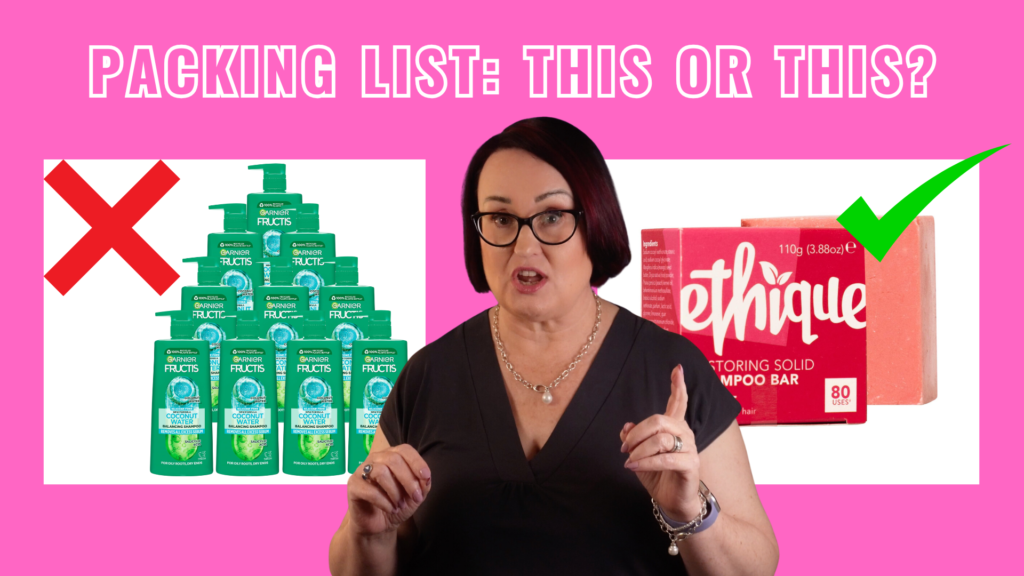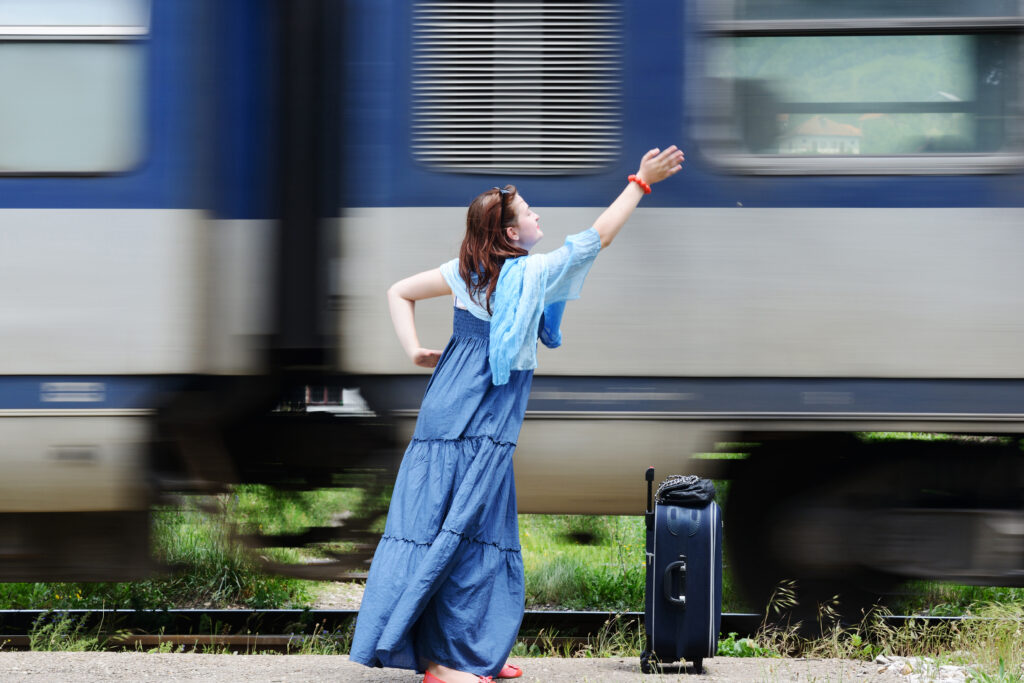LIGHTEN your travel toiletries kit

Are you attempting one bag travel or just wish you could reduce the size of your travel toiletries kit? My travel hacks will help you travel light and minimize your travel size toiletries. No more worrying about the 3-1-1 rule! Now, let me be honest—I’m not someone who travels with just a carry-on bag. I usually check a suitcase. However, over the last couple of years, I’ve been working hard to lighten our luggage, particularly when it comes to toiletries. You might be wondering why I’m so focused on packing light today. Well, we’re gearing up for a six-week adventure in North America and Bermuda! We’re incredibly excited—we’ll be cruising from Montreal to New York, spending two fantastic weeks in New York City, and then enjoying a seven-day round trip cruise to Bermuda before heading back home to Australia. But there’s been a little twist that has influenced our packing strategy—Michael recently had a fall at home! He tripped over a step (nothing spectacular) and ended up dislocating his shoulder and fracturing the humerus in two places. Ouch! He’s recovering after surgery, but since he’ll be in a sling until we depart, we need to keep our luggage light to make things easier for both of us. The bulk of our packing reduction starts with liquids. Most liquids pack a heavy punch due to their high water content. So, I want to pass on the benefits of my research to you! We’ll cover the rules for taking liquids onboard the plane, explore alternatives to liquids, discuss what to leave behind, and finally, how to pack everything effectively. Onboard liquids I’m Australian, but the TSA rules in the USA often come to mind when I think about onboard liquid regulations. Most countries have similar restrictions but remember to check the specific regulations for the country you’re visiting. For instance, the UK has different requirements for the size of clear bags! Leaving Australia on an international flight, the rules relate to powders, liquids, aerosols and gels. I won’t go into details but certain powders, such as washing powder and salt need to be under 350g but don’t have to be packed in a special bag. Liquids, aerosols and gels must be under 100ml and packed in a zip lock bag that measures 80cm or less around the perimeter. All powder, liquid, aerosol and gel products must be taken out at security. You can have one liquids bag per person. Personally, I’ve had good luck getting through without having to pull them out, but it’s always best to follow the packing guidelines just in case. Flying in the USA you have the 3 1 1 rule – each product must be under 3.4 ounces, which is 100ml, be put in a bag that is 1 quart or less (just under a litre) and one bag is allowed per person. I’ve included links in the text above, but I found this information quite easily by searching “flying liquids Australia” and “flying liquids USA” so do the same for the country you’re visiting to ensure that you know what to do. Now, we get to the tricky part—what actually counts as a liquid? Items like mascara and lipstick often cause confusion. A handy tip is to think about whether the product can hold its shape without a container at room temperature. Mascara would definitely be considered a liquid, whereas a lipstick would not—although lip gloss? Yep, that’s a liquid! Don’t forget, there are exemptions for things like medications and baby food, but it’s wise to check the regulations specific to the country you’re visiting. Of course, none of this applies to liquids in checked in bags, but if you are going to travel carry on only you will need to have a really good understanding of the rules! Replacements Why bother with liquids when you can replace them with solid alternatives? Liquid products tend to be heavier, simply because they usually have a higher water content. For example, when I weighed a litre of milk, it clocked in at about one kilo (35.27oz). Meanwhile, the milk powder to make one litre weighed only 130 grams (4.59oz). You can see it by looking at the ingredients list on any product – the ingredients are listed from highest to lowest percentage and the first one is nearly always aqua – that’s water! Take shampoo, for instance. I carry a mini shampoo bar instead of liquid shampoo when I travel. I’ve been using a sample sized bar for six weeks of travel all up, and it’s barely any smaller. I can still see the embossed pattern on it, which tells you just how little has been worn away. If I’d taken liquid shampoo I would have used a fairly large bottle over the same period, and the whole bar must be worth at least ten bottles! There are two more reasons I prefer non-liquid alternatives, and they don’t relate to travel – one is environmental – producing and transporting a shampoo bar instead of ten bottles has a much lower impact on the environment. The second is frugality – it costs a whole lot less for that one bar instead of ten bottles of shampoo! So, at home I use a shampoo bar and toothpaste tablets and plan to replace other items as I run out of the liquid versions. Now, you might have stumbled upon YouTube videos where some travellers have gone completely non-liquid with their toiletries. While I admire that approach, I’ve learned that there are some items I prefer in liquid form—like body lotion, for example. However, even if you switch out just half or a quarter of your products, you’re already making a substantial difference! For my hair care, I use a full-sized Ethique shampoo bar at home. For travel, I have a travel-sized Superzero shampoo bar—thank you, Sephora, for that gift with purchase! I’ve been using the Ethique bar for about 18 months, and I’d estimate it’s just over half used. I
Travel tips for solo women travellers – including safety!

No one understands the need for safety quite like another woman. We’ve all spent years considering how we dress, behave, and what we carry with us to reduce our vulnerability. Who hasn’t found herself walking alone at night, clutching her keys like a weapon, ready to defend against a potential attacker? Who hasn’t felt a rush of anxiety upon hearing footsteps behind her, wondering if they’re a threat or just someone going about their day? Unfortunately, feeling completely safe is something many women miss out on—a reality that’s often not understood by men. But that shouldn’t stop us from embarking on solo travel! With careful planning and a focus on safety, we can explore the world confidently. Preparation It’s vital to thoroughly research your destination before you set off. Familiarise yourself with everything from safety tips, local customs, and travel advisories to potential issues related to your insurance and documentation. Remember, knowledge is power. The more you know about your destination, the more empowered you’ll feel. If you’re still deciding where to go, consider researching destinations that are known for being safe for solo female travellers. Once you’ve chosen your destination, dive into specifics. Identify the safest areas to stay and be aware of any common scams that might catch unwitting tourists off guard. Don’t forget to review your government’s travel website—it offers valuable insights into potential safety risks across the globe. Australian government travel advisory US government travel advisory UK government travel advisory Canadian government travel advisory You need to prepare your travel insurance and your documentation. Is your passport ready to go? Does your travel insurance cover the destination and any valuables you intend to take with you? Does it cover all activities you plan to do – you usually need to notify them about anything high risk, such as skiing. Always make sure your travel insurance information is accessible – I keep mine on my phone but what if my phone breaks or is stolen? I can also access it from my iPad and laptop, but you may feel safer with a hard copy backup. You should also keep a copy of your passport, your hotel address and local emergency numbers as a backup too. Learn a little of the language, if the country you are going to does not speak the same language as you. Even just please, thank you, hello, goodbye can make you feel more comfortable and less out of place. Update your ICE contact in your phone. Make sure it is accessible if you were to need medical attention whilst unconscious – most phones from the last few years can do this, so research how to do it on yours. And finally, save offline maps in Google maps in case you don’t have wifi or a network accessible where you are going. Packing A top tip here is to avoid overpacking. Ensure you can handle your own bags comfortably, as you’ll need to keep them with you in public toilets and other tight spaces. You won’t want to rely on others for assistance, because this can increase the risk of theft. Place an Apple Air Tag or similar device in all your bags. This way, you can always monitor their location. Use physical luggage tags with minimal personal information; I just put our surname, “Linke” and Michael’s mobile phone number on ours. I don’t want someone seeing a female name, or address details on my tags. Or being able to send me harassing texts or photos. Be smart about what you pack. Leave behind any sentimental items that cannot be replaced. This way, if anything goes missing or gets stolen, you can rely on your travel insurance for replacements. Ensure you check whether you need to itemise valuable items, such as cameras, with your insurer. Refrain from taking and wearing expensive jewellery or flashy clothing. These items can attract unwanted attention, leading thieves to assume you’re carrying a lot of cash. Always pack your valuables in multiple locations. Keep cash and credit cards in separate spots, so you have a backup if something gets lost or taken. Consider using RFID-blocking sleeves for your cards and passport, for added protection. Your medications may be valuable on the black market so protect them too! As for safety gadgets, consider packing a few items that can provide an extra layer of security. For instance, a portable door lock can secure your hotel room, while portable alarms or motion-activated lights can keep unwelcome visitors at bay. Some travellers even swear by using an old phone as a webcam in their hotel room, along with an app like Alfred, to monitor for any unexpected intruders while they are out. I’ll link all the gadgets I’m aware of in the description below, so feel free to check them out. Transport and tours Staying aware whilst navigating transportation is critical. Using rideshares like Uber can offer a sense of safety, but it’s essential to verify that the license plate matches what you see in the app. If you have luggage in the boot – trunk for Americans – wait until the driver exits the vehicle before you do, to avoid them driving off with your possessions. If you are hailing a taxi, take a photo of the licence plate before you get in. And whether it’s an Uber or a taxi, if you’re in an unfamiliar location follow along on a map to make sure you aren’t being taken to the wrong place! If traveling from home to the airport with luggage, which makes it obvious that I’m going away, I often have a fake phone conversation with a friend to talk about them housesitting with their big scary boyfriend—this trick can deter potential house breakers. When booking tours, choose reputable companies with positive reviews, and if it helps your sense of security, look for options tailored specifically for women. Always have a plan in place for what happens if you get separated from the group. In general, exercise

